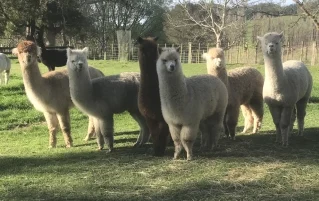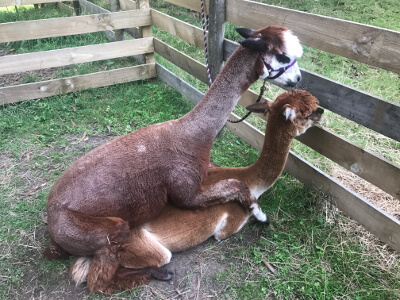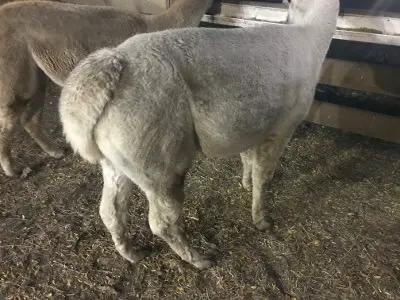
Farm Tours
We offer farm tours for smaller groups and families to meet, feed, interact with and walk with our alpacas.
For full details and to book your experience of these wonderful animals, please go to our reservation form.
If you cannot find what you are looking for in this page, please send a note to tell me so that I can write on the subject for you and future visitors.
Although male alpacas reach reproductive age at about 18 months, they should not be allowed to mate until at least 2½ years of age. Earlier matings may result in damage to the penis if the prepuce has not detached from the tip, a process that is not complete in 100% of males until 3 years old [24]. Damage caused by premature matings may then result in associating mating with pain and prevent a successful stud career. Moreover, the testes do not physically mature until 3 years of age and a correlation has been shown between testicular length and the onset of sperm production [72].
It is common practice in New Zealand to start mating females at around 2 years old when there is physical and mental maturity and she may breed until she is about 15 years old. Mating can start after shearing in late spring though is commonly done after New Year so that the cria are born during the following summer.
In the wild, South American camelids are seasonal breeders and this is driven by favourable climatic conditions [82]. Farmed female camelids do not have a breeding season but are induced ovulators.
Previously, it was believed that the act of mating resulted in the dam ovulating and although this may contribute, it is now known that a stimulating protein factor (known from unrelated studies as β-nerve growth factor) is deposited with the sperm directly into the uterus [3]. As a result, ovulation occurs within 48 hours and the egg is then fertilised. As a result of ovulation, a functional corpus luteum forms 2-3 days later. The fertilized egg may be found in the uterus seven days after mating and this implants at around 30 days. The functional corpus luteum is responsible for the production of progesterone and after about one week post-mating, the increased levels of this hormone start to cause changes in the alpaca's behaviour. There is a clear relationship between progesterone level and being receptive to males - those females with elevated levels are unreceptive to the advances of a male. Although ovulation occurs equally between left and right ovaries, pregnancies are invariably carried in the left horn of the uterus. An embryo created in the right horn must therefore migrate to the left - the mechanism for this is unclear.
Very occasionally, a corpus luteum remains functional and secreting progesterone even without an active pregnancy. This results in the female being unreceptive to males and is known as a retained corpus luteum. A vet is able to treat this with injections of a prostaglandin, PGF2α.
On introduction of a male, a receptive female will kush (sit) for the male to mount her which he does whilst making a distinctive orgeling sound, believed to be another contributing factor to the induction of ovulation. It is noteworthy that females can be induced to ovulate by sitting next to an enclosure where mating is happening. Some females will not initially be receptive to the male who may bite at the back legs or rise up and put his weight on the hind-quarters to make the female cush. Other females will be totally unreceptive to the male's advances and do everything she can to avoid mating. The reason for this could include that the female simply does not like the male or perhaps already has a high progesterone level for whichever reason. Later attempts to mate this alpaca pair may be successful but it must be remembered that the females are instinctively selective.

There are two breeding methods:
Enter the mating date (day/month/year):
Camelids are reported to have a high rate of early abortion, mostly within the first month. The results of a 1993 postal questionnaire indicated that a third of mated female South American camelids in the United Kingdom failed to produce offspring. This did not include abortions or stillbirths at up to 4 per cent and up to 3 per cent of further losses respectively [75]. Other estimations range between 7% [73] and 25% [74] thus making pregnancy confirmation at regular intervals during the first months critical. The causes of these abortions are usually not identified though possible reasons range from infections, genetic incompatibility, inappropriate drug use to toxic plants and more. These possibilities have been discussed in a recent review paper [86]. If pregnancy was not achieved, the dam's serum progesterone level drops back to normal by 14 days after which she will sit ready to be mated again. The induction of ovulation and resulting 14 day progesterone cycle should be considered when mating and remating.
Gestation averages 350 days from the conception date with a few not unpacked (born) for 380+ days. Swelling of the abdomen may be noticeable in the last months and is particularly visible on the shearing table. Cria movements and occasional kicks are clearly visible in the last month. It should be added that some dams hide the pregnancy well, even to the experienced eye.
It is good practice to record all breeding activities and observations for future reference.
Confirmation of pregnancy can be done by:

Pregnancies are invisible to the eye until the latter months as the foetus is only about the size of a small bird at six months gestation and increasing staple length disguises any swelling of the abdomen. If the dam is suckling the previous year's cria, she will wean it by refusing to give it further milk. The dam will 'dry off' and growth of the new foetus can then accelerate. Movements of the foetus are evident in the final two months and can be occasionally seen as a rolling motion or kicking of the abdominal wall. Swelling of the udders occurs at about two weeks before unpacking. Note that some females can reach term without showing much, if any, swelling of the abdomen or obvious udder development.
In New Zealand, shearing is frequently done within 30 days of the unpacking date and even restrained on the shearing table it can be difficult to visually confirm pregnancy. However, some maiden dams will show slight udder development and swollen teats in the final couple of months before term. For all dams, ultrasound is the definitive method confirming pregnancy though for most owners their behaviour towards males is the practical indicator that they remain pregnant. Be aware that some dams, even well advanced in their pregnancy, will present 'mixed signals' when brought near a male showing great interest with their tails raised.
The great majority of dams will unpack within the 340-370 days window with most crias arriving in the warmest hours between 11 am and 4 pm. If the weather conditions are poor or likely to deteriorate, the dam is able to defer going into labour. This is a legacy of evolving at high altitude where the maternal instinct is to time unpacking during good weather. This gives her cria the greatest chance of survival as it must dry, stand and feed quickly. Identifying the typical behaviours of a dam going into labour is not easy and around the expected unpacking date, requires either frequent paddock visits, having a well placed live-feed video camera or ideally, having a birthing paddock next to the house.
This can be broken into three stages:
Birthing Kits.
It is advisable to have one ready which should ideally contain the following:
It should be emphasised that neither the unpacking cria nor the placenta should be pulled to 'assist' their passage. Doing this can cause serious damage to the dam.
A page containing photographs of a cria unpacking which covers all of the birthing stages has been added for illustration.
Dystocia (abnormal labour) is unusual in alpacas but indicated if stage 1 of labour is longer than 4 hours or the dam shows distress through repeated standing, sitting, rolling and vocalising. Should this be seen, a veterinarian must be called immediately. The most common dystocia involves the head and a single leg emerging but the other leg being retained in the uterus - a situation that may be corrected with veterinary intervention. This happened recently at Te Korito Alpacas and has been written up as an article.
Care of the newborn (unpacked) cria is now covered on this page.
Most of the literature below can be accessed by clicking on the highlighted link. Some links will access the appropriate web page from which the article can be downloaded but others will immediately start downloading the full reference.
3. Kershaw-Young, C.M., Druart, X., Vaughan , J. and Maxwell, W. M. C. (2012). β-Nerve growth factor is a major component of alpaca seminal plasma and induces ovulation in female alpacas. Reproduction, Fertility and Development, 24(8): 1093-1097.
24. Cebra, C., Anderson, D.E., Tibary, A., Van Saun, R.J. and Johnson, L.W. (2014). Llama and Alpaca Care, Ch.15. 1st Ed., Elsevier.
72. Abraham, M.C., Puhakka, J., Ruete, A., Al‐Essawe, E.M., de Verdier, K., Morrell, J.M. and Båge, R. (2016). Testicular length as an indicator of the onset of sperm production in alpacas under Swedish conditions. Acta Vet. Scand. 58: 10-19.
73. Pearson, L.K., Rodriguez, J.S. and Tibary, A. (2014). Disorders and Diseases of Pregnancy. In Llama and Alpaca Care. Medicine, Surgery, Reproduction, Nutrition, and Herd Health; Cebra, C., Anderson, D.E., Tibary, A., Van Saun, R., Johnson, L.W., Eds.; Elsevier Saunders: St. Louis, MO, USA. pp. 256–276.
74. Van Saun, R.J. (2008). Effect of Nutrition on Reproduction in Llamas and Alpacas. Theriogenology, 70: 508–514.
75. Wright, A., Davis, R., Keeble, E. and Morgan, K.L. (1998). South American camelids in the United Kingdom: reproductive failure, pregnancy diagnosis and neonatal care. Vet. Record, 142(9): 214-215.
76. Gazitúa, F.J., Corradini, P., Ferrando, G., Raggi, L.A. and Parraguez, V.H. (2001). Prediction of gestational age by ultrasonic fetometry in llamas (Lama glama) and alpacas (Lama pacos). Anim. Reprod. Sci., 66: 81-92.
77. Kero, L.L. (2019). Relaxin as a tool for pregnancy diagnosis in alpacas. B.Vet. Thesis, Faculty of Veterinary Medicine and Animal Science, Swedish University of Agricultural Sciences, Uppsala.
82. San Martin, M., Copaira, M., Zaiga, J., Rodriguez R., Bustinza, G. and Acosta, L. (1968). Aspects of reproduction in the alpaca. J. Reprod. Fert., 16: 395-399.
86. Eggimann, H., Rediger, I., Hirsbrunner, G. and Zanolari, P. (2024). Infectious and non-infectious causes for pregnancy loss in South American camelids – A review. An. Reprod. Sci. 268:107571.